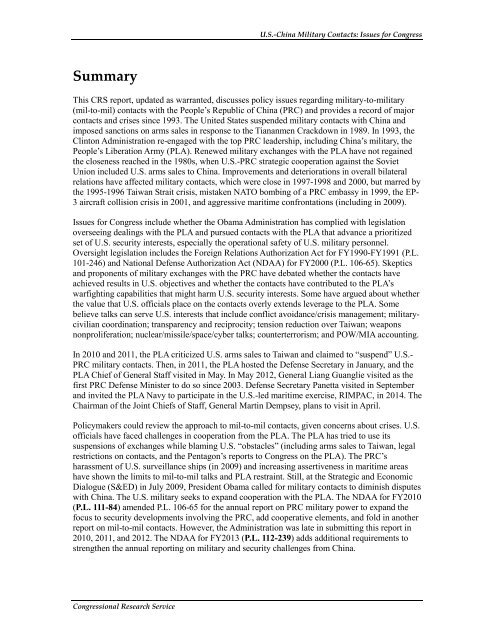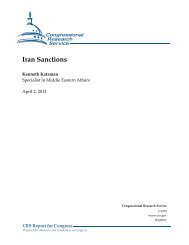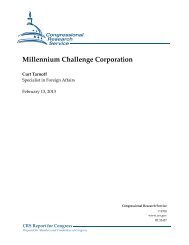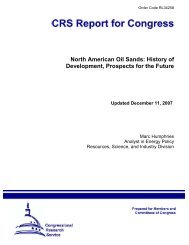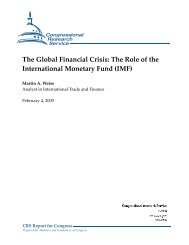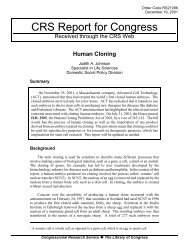U.S.-China Military Contacts: Issues for Congress - Foreign Press ...
U.S.-China Military Contacts: Issues for Congress - Foreign Press ...
U.S.-China Military Contacts: Issues for Congress - Foreign Press ...
You also want an ePaper? Increase the reach of your titles
YUMPU automatically turns print PDFs into web optimized ePapers that Google loves.
Summary<br />
<strong>Congress</strong>ional Research Service<br />
U.S.-<strong>China</strong> <strong>Military</strong> <strong>Contacts</strong>: <strong>Issues</strong> <strong>for</strong> <strong>Congress</strong><br />
This CRS report, updated as warranted, discusses policy issues regarding military-to-military<br />
(mil-to-mil) contacts with the People’s Republic of <strong>China</strong> (PRC) and provides a record of major<br />
contacts and crises since 1993. The United States suspended military contacts with <strong>China</strong> and<br />
imposed sanctions on arms sales in response to the Tiananmen Crackdown in 1989. In 1993, the<br />
Clinton Administration re-engaged with the top PRC leadership, including <strong>China</strong>’s military, the<br />
People’s Liberation Army (PLA). Renewed military exchanges with the PLA have not regained<br />
the closeness reached in the 1980s, when U.S.-PRC strategic cooperation against the Soviet<br />
Union included U.S. arms sales to <strong>China</strong>. Improvements and deteriorations in overall bilateral<br />
relations have affected military contacts, which were close in 1997-1998 and 2000, but marred by<br />
the 1995-1996 Taiwan Strait crisis, mistaken NATO bombing of a PRC embassy in 1999, the EP-<br />
3 aircraft collision crisis in 2001, and aggressive maritime confrontations (including in 2009).<br />
<strong>Issues</strong> <strong>for</strong> <strong>Congress</strong> include whether the Obama Administration has complied with legislation<br />
overseeing dealings with the PLA and pursued contacts with the PLA that advance a prioritized<br />
set of U.S. security interests, especially the operational safety of U.S. military personnel.<br />
Oversight legislation includes the <strong>Foreign</strong> Relations Authorization Act <strong>for</strong> FY1990-FY1991 (P.L.<br />
101-246) and National Defense Authorization Act (NDAA) <strong>for</strong> FY2000 (P.L. 106-65). Skeptics<br />
and proponents of military exchanges with the PRC have debated whether the contacts have<br />
achieved results in U.S. objectives and whether the contacts have contributed to the PLA’s<br />
warfighting capabilities that might harm U.S. security interests. Some have argued about whether<br />
the value that U.S. officials place on the contacts overly extends leverage to the PLA. Some<br />
believe talks can serve U.S. interests that include conflict avoidance/crisis management; militarycivilian<br />
coordination; transparency and reciprocity; tension reduction over Taiwan; weapons<br />
nonproliferation; nuclear/missile/space/cyber talks; counterterrorism; and POW/MIA accounting.<br />
In 2010 and 2011, the PLA criticized U.S. arms sales to Taiwan and claimed to “suspend” U.S.-<br />
PRC military contacts. Then, in 2011, the PLA hosted the Defense Secretary in January, and the<br />
PLA Chief of General Staff visited in May. In May 2012, General Liang Guanglie visited as the<br />
first PRC Defense Minister to do so since 2003. Defense Secretary Panetta visited in September<br />
and invited the PLA Navy to participate in the U.S.-led maritime exercise, RIMPAC, in 2014. The<br />
Chairman of the Joint Chiefs of Staff, General Martin Dempsey, plans to visit in April.<br />
Policymakers could review the approach to mil-to-mil contacts, given concerns about crises. U.S.<br />
officials have faced challenges in cooperation from the PLA. The PLA has tried to use its<br />
suspensions of exchanges while blaming U.S. “obstacles” (including arms sales to Taiwan, legal<br />
restrictions on contacts, and the Pentagon’s reports to <strong>Congress</strong> on the PLA). The PRC’s<br />
harassment of U.S. surveillance ships (in 2009) and increasing assertiveness in maritime areas<br />
have shown the limits to mil-to-mil talks and PLA restraint. Still, at the Strategic and Economic<br />
Dialogue (S&ED) in July 2009, President Obama called <strong>for</strong> military contacts to diminish disputes<br />
with <strong>China</strong>. The U.S. military seeks to expand cooperation with the PLA. The NDAA <strong>for</strong> FY2010<br />
(P.L. 111-84) amended P.L. 106-65 <strong>for</strong> the annual report on PRC military power to expand the<br />
focus to security developments involving the PRC, add cooperative elements, and fold in another<br />
report on mil-to-mil contacts. However, the Administration was late in submitting this report in<br />
2010, 2011, and 2012. The NDAA <strong>for</strong> FY2013 (P.L. 112-239) adds additional requirements to<br />
strengthen the annual reporting on military and security challenges from <strong>China</strong>.


